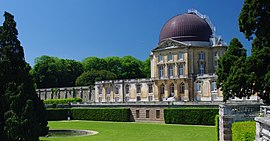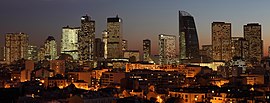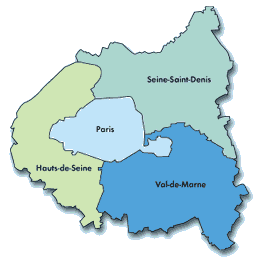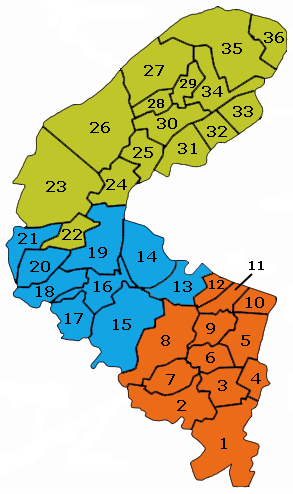Hauts-de-Seine
Hauts-de-Seine | |
|---|---|
     From top down, left to right: a view of Boulogne-Billancourt from the Parc de Saint-Cloud, Meudon site of the Paris Observatory, the Château de Sceaux, lake in Rueil-Malmaison, La Défense seen from La Garenne-Colombes | |
 Flag  Coat of arms | |
 Location of Hauts-de-Seine in France | |
| Coordinates: 48°50′N 02°12′E / 48.833°N 2.200°ECoordinates: 48°50′N 02°12′E / 48.833°N 2.200°E | |
| Country | France |
| Region | Île-de-France |
| Prefecture | Nanterre |
| Subprefectures | Antony Boulogne- Billancourt |
| Government | |
| • President of the Departmental Council | Georges Siffredi (LR) |
| Area | |
| • Total | 176 km2 (68 sq mi) |
| Population (2016) | |
| • Total | 1,603,268 |
| • Rank | 5th |
| • Density | 9,100/km2 (24,000/sq mi) |
| Time zone | UTC+1 (CET) |
| • Summer (DST) | UTC+2 (CEST) |
| Department number | 92 |
| Arrondissements | 3 |
| Cantons | 23 |
| Communes | 36 |
| ^1 French Land Register data, which exclude estuaries and lakes, ponds and glaciers larger than 1 km2 | |
Hauts-de-Seine (French: [o d(ə) sɛn] (![]() listen); lit. 'Seine Heights') is a department in the Île-de-France region of Northern France. It covers Paris's western inner suburbs. With a population of 1,603,268 (as of 2016) and a total area of 176 square kilometres (68 square miles), it is the second most highly densely populated department of France after Paris. Its prefecture is Nanterre although Boulogne-Billancourt, one of its two subprefectures alongside Antony, has a larger population.
listen); lit. 'Seine Heights') is a department in the Île-de-France region of Northern France. It covers Paris's western inner suburbs. With a population of 1,603,268 (as of 2016) and a total area of 176 square kilometres (68 square miles), it is the second most highly densely populated department of France after Paris. Its prefecture is Nanterre although Boulogne-Billancourt, one of its two subprefectures alongside Antony, has a larger population.
Hauts-de-Seine is best known for containing the modern office, cinema and shopping complex La Défense, one of Grand Paris's main economic centres and one of Europe's major business districts. Hauts-de-Seine is one of the wealthiest department in France; it has the highest GDP per capita at €104,000 in 2016.[1] Its inhabitants are called Altoséquanais in French.
History[]
The Hauts-de-Seine department was created in 1968, from parts of the former departments of Seine and Seine-et-Oise. Its creation reflected the implementation of a law passed in 1964; Nanterre had already been selected as the prefecture for the new department early in 1965.
In 2016, the Departmental Council of Hauts-de-Seine voted in favour of a fusion of Hauts-de-Seine and Yvelines, its western neighbour. Following a similar vote in Yvelines, an établissement public interdépartemental was established. The fusion will proceed if voters in both departments return a favourable majority of councillors in the .[2] The name Seine-et-Oise (department abolished in 1968) has been discussed for a new department.
Demographics[]
Population development since 1881[]
| Year | Pop. | ±% p.a. |
|---|---|---|
| 1881 | 254,928 | — |
| 1891 | 332,076 | +2.68% |
| 1901 | 467,391 | +3.48% |
| 1911 | 614,862 | +2.78% |
| 1921 | 724,261 | +1.65% |
| 1931 | 949,231 | +2.74% |
| 1936 | 1,019,627 | +1.44% |
| 1946 | 992,859 | −0.27% |
| 1954 | 1,118,020 | +1.50% |
| 1962 | 1,381,805 | +2.68% |
| 1968 | 1,461,619 | +0.94% |
| 1975 | 1,438,930 | −0.22% |
| 1982 | 1,387,039 | −0.52% |
| 1990 | 1,391,658 | +0.04% |
| 1999 | 1,428,881 | +0.29% |
| 2006 | 1,536,100 | +1.04% |
| 2011 | 1,581,268 | +0.58% |
| 2016 | 1,603,268 | +0.28% |
| source:[3] | ||
Place of birth of residents[]
| Born in metropolitan France | Born outside metropolitan France | |||
|---|---|---|---|---|
| 80.6% | 19.4% | |||
| Born in overseas France |
Born in foreign countries with French citizenship at birth1 | EU-15 immigrants2 | Non-EU-15 immigrants | |
| 1.5% | 3.5% | 3.8% | 10.6% | |
| 1 This group is made up largely of former French settlers, such as Pieds-Noirs in Northwest Africa, followed by former colonial citizens who had French citizenship at birth (such as was often the case for the native elite in French colonies), as well as to a lesser extent foreign-born children of French expatriates. Note that a foreign country is understood as a country not part of France in 1999, so a person born for example in 1950 in Algeria, when Algeria was an integral part of France, is nonetheless listed as a person born in a foreign country in French statistics. 2 An immigrant is a person born in a foreign country not having French citizenship at birth. Note that an immigrant may have acquired French citizenship since moving to France, but is still considered an immigrant in French statistics. On the other hand, persons born in France with foreign citizenship (the children of immigrants) are not listed as immigrants. | ||||
Geography[]
Situation[]
Hauts-de-Seine and two other small departments (Seine-Saint-Denis and Val-de-Marne) form an inner ring around Paris, known as the Petite Couronne (literal translation: "Little Crown"). Together with the City of Paris, they are included in the Grand Paris since 1 January 2016.

Administration[]
Hauts-de-Seine comprises three departmental arrondissements and 36 communes:
| Map number | Name | Area (km2) | Population | Coat of arms | Arrondissement | Map | Labelled map |
|---|---|---|---|---|---|---|---|
| 1 | Antony | 9.56 | 62,570 | Antony | 
|

| |
| 2 | Châtenay-Malabry | 6.38 | 33,286 | 
| |||
| 3 | Sceaux | 3.6 | 19,344 | 
| |||
| 4 | Bourg-la-Reine | 1.86 | 20,667 | 
| |||
| 5 | Bagneux | 4.19 | 40,918 | 
| |||
| 6 | Fontenay-aux-Roses | 2.51 | 24,564 | 
| |||
| 7 | Le Plessis-Robinson | 3.43 | 29,100 | 
| |||
| 8 | Clamart | 8.77 | 52,971 | 
| |||
| 9 | Châtillon | 2.92 | 37,355 | 
| |||
| 10 | Montrouge | 2.07 | 50,260 | 
| |||
| 11 | Malakoff | 2.07 | 30,720 | 
| |||
| 12 | Vanves | 1.56 | 27,729 | 
| |||
| 13 | Issy-les-Moulineaux | 4.25 | 68,451 | Boulogne-Billancourt | 
| ||
| 14 | Boulogne-Billancourt | 6.17 | 120,071 | 
| |||
| 15 | Meudon | 9.9 | 45,352 | 
| |||
| 16 | Sèvres | 3.91 | 23,507 | 
| |||
| 17 | Chaville | 3.55 | 20,520 | 
| |||
| 18 | Ville-d'Avray | 3.67 | 11,453 | 
| |||
| 19 | Saint-Cloud | 7.56 | 29,973 | 
| |||
| 20 | Marnes-la-Coquette | 3.48 | 1,810 | 
| |||
| 21 | Vaucresson | 3.08 | 8,667 | 
| |||
| 22 | Garches | 2.69 | 17,869 | Nanterre | 
| ||
| 23 | Rueil-Malmaison | 14.7 | 78,152 | 
| |||
| 24 | Suresnes | 3.79 | 48,264 | 
| |||
| 25 | Puteaux | 3.19 | 44,645 | 
| |||
| 26 | Nanterre | 12.19 | 95,105 | 
| |||
| 27 | Colombes | 7.81 | 85,177 | 
| |||
| 28 | La Garenne-Colombes | 1.78 | 29,169 | 
| |||
| 29 | Bois-Colombes | 1.92 | 28,239 | 
| |||
| 30 | Courbevoie | 4.17 | 81,719 | 
| |||
| 31 | Neuilly-sur-Seine | 3.73 | 60,361 | 
| |||
| 32 | Levallois-Perret | 2.41 | 64,379 | 
| |||
| 33 | Clichy | 3.08 | 61,070 | 
| |||
| 34 | Asnières-sur-Seine | 4.82 | 85,191 | 
| |||
| 35 | Gennevilliers | 11.64 | 46,907 | 
| |||
| 36 | Villeneuve-la-Garenne | 3.2 | 23,771 | 
|
Economy[]
Hauts-de-Seine is one of France's wealthiest departments and one of Europe's richest areas. Its GDP per capita was €104,000 in 2016, according to Eurostat official figures.[1]
Politics[]
In the 1990s and early 2000s, Hauts-de-Seine received national media attention as the result of a corruption scandal concerning the misuse of public funds provided for the department's housing projects. Implicated were former minister and departmental council president Charles Pasqua, as well as other personalities of the Rally for the Republic (RPR) party.
Hauts-de-Seine was the political base of Nicolas Sarkozy, President of the French Republic from 2007 to 2012. He was Mayor of Neuilly-sur-Seine (1983–2002) and President of the Departmental Council of Hauts-de-Seine (2004–2007) before he assumed the office. Sarkozy succeeded Pasqua as President of the Departmental Council.[4]
Departmental Council of Hauts-de-Seine[]
Hauts-de-Seine is governed by a departmental council. Its 46 members are called departmental councillors. The electorate of Hauts-de-Seine usually votes for right-wing parties; there has never been a left-wing majority since the department's inception in 1968.
The departmental council is the deliberative organ of the department. The executive is led by the council president, assisted by vice presidents, in charge of various portfolios. Departmental councillors are elected (two per canton) by the department's inhabitants for six-year terms (no term limits).
National representation[]
Hauts-de-Seine elected the following members of the National Assembly in the 2017 legislative election:
In the Senate, Hauts-de-Seine is represented by:
- André Gattolin (LREM), since 2011
- Xavier Iacovelli (LREM), since 2017
- Roger Karoutchi (LR), since 2009
- (LR), since 2017
- Hervé Marseille (UDI), since 2011
- (PCF), since 2017
- (LR), since 2017
Tourism[]

Empress Joséphine's bedroom at the Château de Malmaison

Grande Fontaine of the Parc de Saint-Cloud

Cité de la céramique in Sèvres

Japanese garden at the Musée Albert-Kahn in Boulogne-Billancourt
References[]
- ^ Jump up to: a b https://ec.europa.eu/eurostat/web/national-accounts/data/database
- ^ "Fusion Yvelines - Hauts-de-Seine : pas question de rompre les fiançailles maintenant", Le Parisien, 16 June 2020.
- ^ Site sur la Population et les Limites Administratives de la France
- ^ The Power Broker in France's Election / Interior Minister Pasqua embodies nation's social divide
- ^ http://www.assemblee-nationale.fr/
External links[]
- (in French) Website of the General council
- (in French) Prefecture website
- Hauts-de-Seine
- 1968 establishments in France
- Departments of Île-de-France
- States and territories established in 1968




